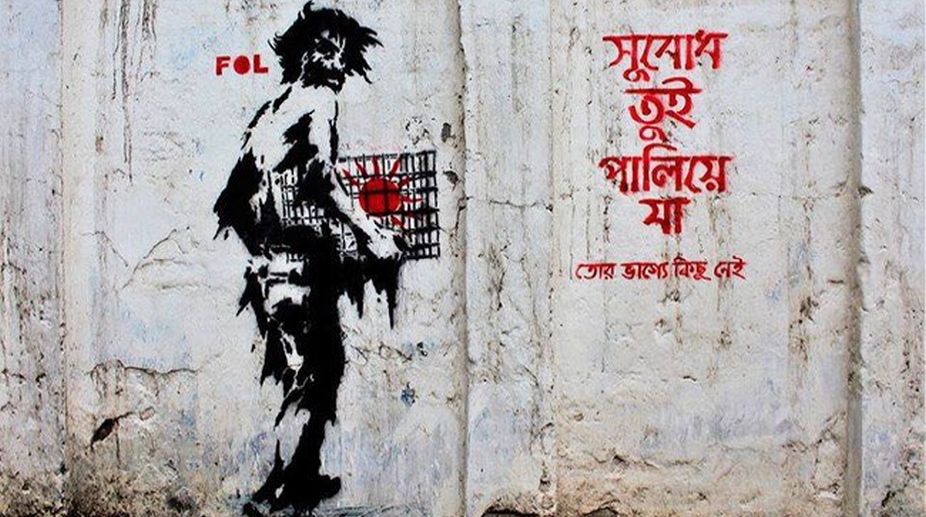In the environment of intolerance that has engulfed Bangladesh, the emergence of graffiti depicting helplessness and hopelessness of oppressed people should serve as hard-hitting indictment of the establishment. The phenomenon of ‘Subodh’ graffiti is being seen since early this year in Bangladesh.
This graffiti, accompanied by a message, depicts a man named Subodh carrying a caged sun who is being urged to run away from his land.
Advertisement
The caged sun in the hands of an unruly, deprived man running away, has been a powerful tool for political communication, across social and online media.
While various interpretations have been given, the most popular one is that Subodh is a member of the minority community being oppressed by the current criminal and radical culture of Bangladesh.
The appearance of graffiti at this time is a poignant reminder of Bangladesh’s original but fast-fading culture of Bengali language nationalism which gave birth to the nation.
It is rapidly being replaced by extremism, with the entire political class to be partly blamed for the unfortunate process. Even though the political class from opposing factions – mainly BNP and the ruling Awami League – may be taking potshots at each other, with elections round the corner, it mostly ends up looking insincere. For both keep pandering to sentiments of division and have not spelled out any vision that could promise liberation from the current crisis which is engulfing the country.
Politically, governance has taken a toss. Besides the direct attack on the country’s culture by the removal and replacement of the Lady Justice statue, the prolonged rift between the government and the Supreme Court raises uncomfortable questions about the Court’s accusations that the Law Ministry is trying to sabotage its authority through extra-constitutional means like influencing the lower courts and their procedures.
This is the heart of the entire tussle over the 16th amendment which the Court plans to scrap. It is a struggle to preserve the Court’s autonomy. The struggle is being waged in other areas too. Consider how civil society is up in arms against the government’s promulgation of Section 57 of the Digital Security Act, which threatens to imprison anyone spreading negative propaganda about the Liberation War and the Father of the Nation.
There is fear that the government will misuse the Act to target dissident journalists and civil society members. Already, even members of opposition are not being spared. They are being physically attacked and their plans to hold even simple rallies are being checked.
The atmosphere on campuses too has vitiated in recent times, with numerous instances of student associations targeting each other’s members, even resulting in physical casualties. The signals of dangerous times to come should be heeded, especially when students of a country begin to fall prey to political extremes, thus taking a country on a regressive path.
Already draconian manifestations of section 57 are being seen – even though the government promises a debate and revision in the coming month. People, especially government officials, are using the Act to settle personal scores, as was clear when recently a child’s hand-drawn picture of Bangabandhu was booked under the Act. With such a political environment prevailing in the country, Subodh graffiti gains significance.
The atmosphere was vitiated more than two years back with attacks on minorities. But now, with so many rapid-fire developments, everyone is being targeted. In a divided society, there is no longer just one set of attackers.
So, the man, Subodh, in the poignant graffiti could stand for anyone, spanning various categories of discontent like unemployed youth, restless labourers, ambushed civil society workers, the minorities, refugees, a person from a hill tribe or any ordinary citizen for that matter.
(The writer is a Researcher at the Institute for Peace and Conflict Studies. The views are personal.)











